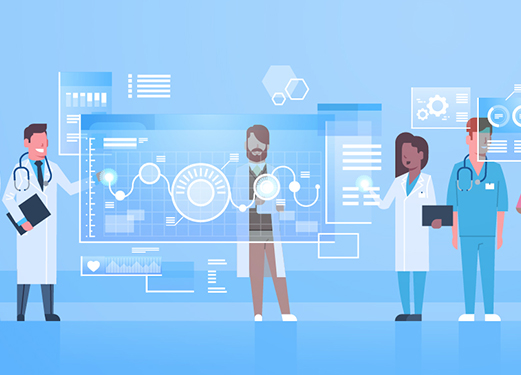
The healthcare industry is known for being one of the slowest adopters of technology. Slowly but steadily though, the industry has started witnessing a significant change in recent years. Healthcare organizations around the world are now speeding up their technology adoption efforts to deliver better patient care.
How Digital Technology and Healthcare go Hand-in-hand
Technology adds value to the existing healthcare ecosystem in multiple ways – from remote patient monitoring and virtual screening to customized treatment plans and early detection of illnesses.
The year 2020 witnessed a global pandemic that made the world realize the importance of technology in healthcare, especially to deliver remote care. It prompted the industry to lookout for digital ways to treat their patients, predict and prevent illnesses, increase efficiency, and ultimately reduce costs.
Technologies – What to Look Out For
From Artificial Intelligence to smart wearables, the advancement of technologies has eased many processes in the healthcare ecosystem.
Following are the top 5 technology trends that have the biggest impact in the healthcare space and will turn out to be the key players in transforming the industry in 2020 and beyond:
1. Use of AI and ML in Healthcare
AI and ML offer new and better ways of predicting, preventing, and identifying a wide range of medical conditions, developing treatment plans, monitoring health conditions, creating efficiencies in trials, and increasing the operational efficiency to meet the increasing demands of the healthcare system.
According to McKinsey, healthcare and pharmaceutical industry could save up to $100bn annually by leveraging AI, ML, and Big Data tools to process their data. AI algorithms can learn from the data to predict illnesses and help doctors in formulating a treatment plan.
2. Cloud Computing in Healthcare
The need for a secure infrastructure to digitally maintain health records of patients is one of the top priorities for every healthcare organization. Today, a variety of private, public, and hybrid cloud-based platforms are available in the market. Patients and healthcare providers both tend to get better access to records through such platforms, which makes the consultation process far more convenient.
Public cloud allows access to a wide range of general health information. The private cloud can be utilized for more security-sensitive requirements, such as pharmacy bills and physician inquiries. Hybrid cloud solutions, on the other hand, provide some of the best benefits of cloud computing in healthcare.
An important aspect to consider here is the HIPAA compliance – organizations need to be aware that their cloud service provider caters to their requirement within the ambit of HIPAA compliance. For an example, read how Harbinger Group modified an existing doctor-patient collaboration platform to be HIPAA compliant.
3. Telemedicine
Telemedicine is a growing trend for many years now, but it gained tremendous importance during the pandemic. Telemedicine, or the concept of using technology to access healthcare providers remotely through video calls, has emerged as one of the most popular healthcare trends in 2020, with the consumer sentiment predicting that telemedicine is here to stay.
While the current video-chat-platforms define telemedicine services, it can do a lot more. For example, telemedicine has helped hospitals reduce their patient readmissions by providing real-time monitoring of patients outside their hospitals. The use of smart wearables and health monitoring apps compliment the use of telemedicine services.
4. Internet of Medical Things (IoMT)
Several smart wearables and mobile apps in the market today play a key role in tracking and preventing chronic illnesses. The combination of IoT and telemedicine has resulted in IoMT, which includes a number of smart wearables, ECG and EKG monitors, and more.
IoMT helps in providing more accurate diagnoses, has fewer errors, and lower costs of care. Internet connectivity allows mobile apps and wearables to send the patients’ health data to their doctors for regularized health tracking. IoMT reduces the patient’s need for in-person visits with their doctors. According to Goldman Sachs, IoMT will save up to $300bn annually through remote patient monitoring and improved medication adherence.
By integrating with AI, IoMT is poised for even better growth and can prove to be capable of real-time, remote measurement, and analysis of patient data. Do watch this webinar that shares an overview of IoT in healthcare to know more.
5. Health Tech integration
The most crucial offering is Health Tech integration. Why do we mention it at the very last? Simply because any of the above-mentioned trends – be it patient engagement through telemedicine or remote patient monitoring with the help of IoMT – can be more easily supported with integrations.
An increasing number of technologies and tools are now available like Augmented Reality (AR), Virtual Reality (VR), Mixed Reality (MR), 3D printing, Blockchain, Predictive Analysis, Robotics, 5G, etc., which have multiple applications in the healthcare industry. Integration allows blending in – expertise from caregivers, feedback from patients, and recommended health monitoring plans – thus providing comprehensive integrated care.
Interestingly, the healthcare integration market is positively impacted by the pandemic, with its estimated value expected to reach $6 billion by 2025 at 11.4% CAGR. For example, EHRs have been in use for more than a decade now, but the market is showing a rapid growth through multiple integration initiatives. Open standards and government regulations will further drive integrations, which will certainly influence the industry.
The ability to address easily diagnosable illnesses and medical conditions using technology enables healthcare professionals to focus on other issues that require personal attention. The right use of technology leads to a more accurate, efficient, and secure way of delivering patient care and improving patient outcomes.






